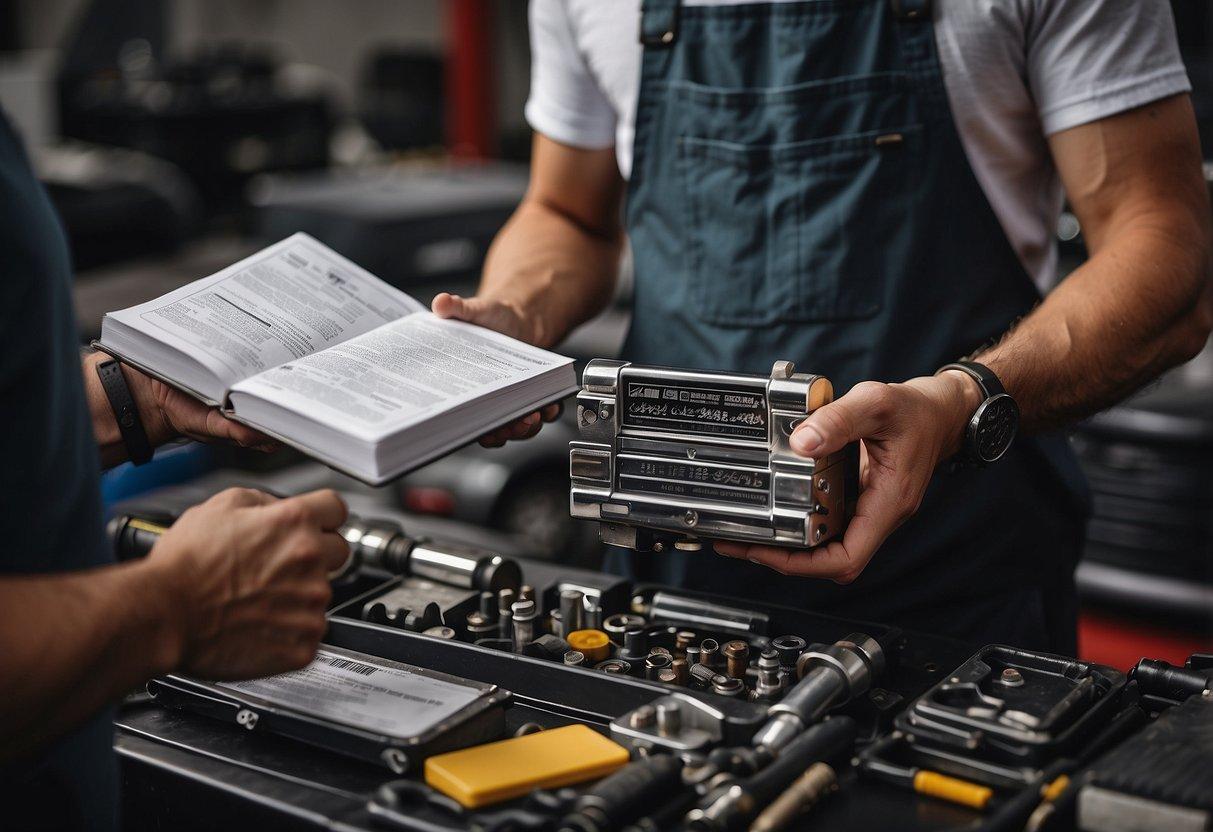When it comes to fixing or maintaining our vehicles, two important resources come into play: the workshop manual and the owner’s manual.
A workshop manual provides detailed, technical instructions for car repairs and maintenance. On the other hand, the owner’s manual is designed for everyday use and offers basic maintenance tips and operating instructions.
Knowing the difference between these manuals can save you a lot of time and effort.
We often rely on the owner’s manual for guidelines on how to operate our cars and perform simple tasks like checking the oil or changing a tire. It’s great for quick references and understanding the basics.
However, when we need to dive deeper into more complex repairs or want to understand the inner workings of our vehicles, the workshop manual is the go-to resource.
This manual covers in-depth troubleshooting, detailed diagrams, and step-by-step repair instructions.
For DIY enthusiasts who enjoy working on their cars, having both manuals on hand is incredibly valuable.
Whether it’s routine maintenance or a major repair project, the workshop manual and the owner’s manual each play a crucial role in guiding us through the process, ensuring that we can keep our vehicles running smoothly and safely.
Key Takeaways
- Workshop manuals provide detailed repair instructions.
- Owner’s manuals cover basic maintenance and operation.
- Both manuals are essential for DIY car enthusiasts.
Understanding Workshop Manuals
Workshop manuals are detailed guides designed for repairing and maintaining cars. They often include diagrams, step-by-step instructions, and troubleshooting tips. These manuals are essential for both professionals and DIY enthusiasts.
Content Overview
Workshop manuals provide in-depth information about a car’s mechanics. These books typically include diagrams, illustrations, and wiring diagrams.
We often find step-by-step instructions that help us tackle repairs systematically.
The content usually covers engine systems, transmissions, electrical systems, brake systems, and more.
Brands like Haynes and Chilton are well-known publishers of these repair manuals. Each section within the manual is designed to help us understand and fix specific issues in our vehicles.
Professional Use
Professionals rely heavily on workshop manuals to ensure accurate repairs.
These manuals, sometimes referred to as Factory Service Manuals, are often used by mechanics and technicians.
They provide precise and expert-level information. The inclusion of detailed diagrams and wiring diagrams helps us understand complex systems better.
This precision ensures that repairs are done correctly and efficiently. By following these manuals, professionals can maintain high standards of service and safety.
Types of Workshop Manuals
There are various types of workshop manuals available.
Some are general repair manuals like those from Haynes and Chilton. These are useful for DIY enthusiasts and cover a wide range of models.
Factory Service Manuals provide the most detailed information. These manuals are specific to a particular make and model. They are written by the car manufacturers and offer expert-level instructions.
Specialized manuals might focus on specific aspects such as electrics or hydraulics. These are especially useful for professionals who need detailed guidance on certain systems.
Deciphering Owner’s Manuals
Owner’s Manuals provide essential details about your car’s features, maintenance schedules, and safety guidelines. They ensure you understand your vehicle’s benefits and how to maintain its reliability.
General Information
Owner’s Manuals cover everything from dashboard controls to advanced safety features. We can find sections on the radio system, air conditioning, and even the seat adjustments here.
This part helps us identify and understand each button, lever, and dial inside the car.
Another important area in this section is safety. For example, we’ll read about airbag locations, seatbelt operations, and how to use child safety locks.
It’s crucial for anyone driving the car to know these details for our safety and the safety of our passengers.
Maintenance Schedules
The Maintenance Schedules section provides a timeline for when to perform essential services.
We find information on oil changes, brake inspections, and tire rotations here. Following these schedules helps us keep our car running smoothly.
Specific intervals, like every 5,000 miles for an oil change or 30,000 miles for transmission service, are listed in detail.
Regular maintenance not only improves reliability but also enhances the vehicle’s longevity. Knowing these schedules helps us avoid costly repairs and ensures our car remains safe to drive.
The DIY Enthusiast’s Guide
For the DIY enthusiast, understanding the difference between workshop manuals and owner’s manuals is crucial for effectively maintaining and repairing a vehicle.
Choosing the Right Manuals for DIY
When we choose manuals for our DIY projects, it’s vital to know which one to pick.
Workshop manuals are comprehensive. They provide details on repairs, parts, and systems. We find step-by-step instructions and diagrams that help with complex tasks.
Owner’s manuals, on the other hand, cover basic operations and maintenance. These include how to change the oil, check fluid levels, and other routine tasks. They explain the functionality of the car’s features and controls.
For in-depth repairs, workshop manuals are indispensable.
If we’re performing an oil change, brake adjustment, or electrical system fixes, these manuals are needed.
Owner’s manuals are great for maintenance schedules and simple fixes, like changing a fuse.
Basic Repairs and Maintenance
Basic repairs and maintenance are key aspects for a DIY enthusiast. Knowing how to handle common issues saves time and money.
Let’s start with an oil change. We need to follow instructions on draining old oil, replacing the filter, and refilling with new oil.
Brake maintenance is another typical task. Inspecting brake pads, rotors, and fluid levels ensures safety.
Workshop manuals provide torque specifications and detailed steps for brake replacement.
Electrical system fixes might include changing bulbs, checking fuses, or replacing the battery. Both manuals guide us through these tasks, with the workshop manual offering more detailed troubleshooting steps.
Vehicle Component Insights
In this guide, we’ll explain key components of your vehicle, such as the engine, transmission, suspension, steering, chassis, and body. Understanding these parts helps us maintain and repair our vehicles more effectively.
Engine and Transmission
The engine is the heart of the vehicle, converting fuel into energy that powers our car. It consists of various parts like pistons, cylinders, and spark plugs.
Regular maintenance such as oil changes and timely component replacement ensures the engine runs smoothly.
The transmission controls power from the engine to the wheels. It can be manual or automatic.
We need to be mindful of fluid levels and listen for unusual noises, which might indicate issues.
Proper care of the transmission prevents costly repairs and ensures a smooth ride.
Suspension and Steering
The suspension system makes our ride comfortable by absorbing bumps. It includes shocks, struts, and springs.
If we notice uneven tire wear or a bumpy ride, the suspension might need attention. Regular inspections help us identify worn-out components early.
Steering allows us to control the vehicle’s direction. It involves the steering wheel, column, and linkage.
If the steering feels stiff or unresponsive, it could be due to low power steering fluid or issues with the pump.
Keeping these components in good shape is crucial for safe driving.
Chassis and Body
The chassis forms the vehicle’s frame and supports all other parts. It needs to be sturdy and free from rust.
We should check for any signs of damage, especially after accidents. Regular underbody cleaning helps prevent rust buildup.
The body is the outer shell, protecting us and the vehicle’s internal components. It includes doors, hood, and trunk.
Keeping the body clean and addressing dents or scratches promptly ensures our vehicle looks good and remains functional. Regular waxing and washing protect the paint and prevent rust.
Tools and Equipment Specifics
We need the right tools and equipment to successfully repair and maintain cars. Using proper gear ensures safety and efficiency, whether for DIY repairs or professional work.
Essential Tools for the Job
For most car repairs, certain tools are necessary. We need wrenches, screwdrivers, and pliers.
A socket set with various sizes is crucial. Torque wrenches help us apply the right amount of force.
Jack stands and a car jack are vital for lifting and securing vehicles safely.
Multimeters measure electrical issues, while OBD-II scanners diagnose computer-related problems.
Work gloves and safety goggles protect us during repairs. A sturdy workbench offers a steady surface for tasks.
When it comes to more specific repairs, we need specialized tools.
For example, a timing light is necessary for engine timing adjustments. Brake repairs require a caliper tool, and suspension work often needs a spring compressor.
Safety and Support Equipment
Safety is a priority. Protective gear like gloves, goggles, and hearing protection is essential.
Fire extinguishers should be nearby in case of fires. Using jack stands and wheel chocks ensures the vehicle won’t move unexpectedly.
We should always work in a well-ventilated area to avoid inhaling fumes.
Drop lights or LED work lights keep our workspace bright and safe. Proper ventilation fans remove harmful vapors.
It’s important to have a first aid kit accessible. We also need non-skid mats to prevent slipping.
Repair and Rebuild Projects
Here, we’ll look at how to tackle major repair and rebuild projects.
Rebuilding the engine and overhauling the transmission are two significant tasks for car enthusiasts.
Engine Rebuilds
Engine rebuilds are complex but rewarding tasks. We follow detailed instructions from repair manuals to ensure every step is correct.
Manuals often provide step-by-step instructions with pictures to guide us.
Using parts from the Original Equipment Manufacturer ensures quality and compatibility. We start by disassembling the engine, inspecting, cleaning, and replacing worn parts.
Reassembly follows after all components are checked and cleaned.
An engine rebuild may involve replacing pistons, rings, bearings, and gaskets. It’s crucial to measure everything precisely to avoid any damage.
Testing the rebuilt engine is the final step. We need to start the engine and check for any issues to ensure everything runs smoothly.
Transmission Overhauls
Transmission overhauls require patience and precision. Repair manuals are essential for these projects. They contain detailed instructions and pictures that help us understand each part of the process.
Disassembling the transmission involves careful labeling of parts to ensure proper reassembly. We inspect gears, bearings, and seals for any wear or damage.
Replacing faulty parts with Original Equipment Manufacturer parts is essential for maintaining the transmission’s integrity. We clean and inspect each part before reassembly.
Reassembling the transmission involves following the manual closely to avoid mistakes. After reassembly, we test the transmission to ensure it shifts smoothly and functions properly.
Online Resources and Support
In today’s digital age, accessing car repair information online has become easier and more convenient. We can find digital manuals and manufacturer’s support resources that can significantly aid in vehicle repair and maintenance.
Digital Manuals and Assistance
Online manuals are a valuable resource for car repairs. Digital repair manuals often contain detailed step-by-step instructions and are easily searchable.
We can find these manuals for free or through paid services. Websites like Haynes and Chilton offer extensive databases of vehicle repair guides.
Forums and video tutorials on platforms like YouTube provide visual aid and community support. These sources are great for DIY enthusiasts looking for specific repairs.
Such detailed guides can make complicated tasks more manageable.
Manufacturer’s Support and Service Bulletins
Manufacturers often provide official support that includes service bulletins and updates. These service bulletins usually contain important information about specific vehicle issues and recommended solutions.
They can be crucial for addressing known problems with particular car models.
Access to these bulletins typically requires going to the manufacturer’s website or through authorized dealer networks. Some sites, like ALLDATA or Mitchell1, offer searchable databases where we can find these documents.
Keeping up with these bulletins helps ensure that our vehicles stay in optimal condition.
Navigating Aftermarket Manuals
When working on car repairs, aftermarket manuals can be very useful. These guides often provide more detailed instructions and information that isn’t in the owner’s manual.
Third-party Manuals Review
We have found that Haynes and Chilton are two of the most popular third-party manual publishers.
Their manuals often include step-by-step instructions, clear diagrams, and tips for both beginner and experienced DIY mechanics.
Haynes manuals often include full-color photographs which make identifying parts and following instructions easier. Meanwhile, Chilton manuals sometimes offer more detailed troubleshooting sections.
Both can be found in print (paper manuals) and online formats.
Using these can save time and reduce the risk of errors. We can quickly find the information needed without having to guess or search in less reliable sources.
These manuals are a great investment for anyone planning to do their own car repairs.
Parts Catalogs and Specs
Locating parts catalogs and specifications within these third-party manuals is another key feature.
We often face difficulty in identifying the right part numbers or specs when doing DIY repairs.
These manuals typically include parts catalogs that list compatible parts along with their numbers. This helps us ensure we buy the right part the first time.
Detailed specifications, such as bolt sizes and torque settings, are also included.
This detailed information means fewer trips to the store and fewer incorrect parts. It’s essential for those working on complex repairs to have accurate specs for each component.
Where to Find Car Repair Manuals
We can obtain car repair manuals from several places, which include both physical and online stores. Knowing where to look helps us find the right manual for our needs quickly.
Retail Outlets and Auto Parts Stores
Retail outlets and auto parts stores are reliable places to buy car repair manuals. Stores like AutoZone often have a section dedicated to car manuals.
Many large bookstores also have automotive sections. We may find popular brands such as Haynes or Chilton.
Retail outlets have the advantage of letting us check the manual’s contents before buying.
Frequently Asked Questions
In this section, we will address common questions about workshop manuals, owner’s manuals, and other car repair guides. We’ll help you understand their differences, benefits, and how to choose the right one for your vehicle.
What distinguishes a workshop manual from an owner’s manual in terms of content?
A workshop manual provides detailed technical information on repairing and maintaining a vehicle. It includes step-by-step instructions, diagrams, and specifications.
On the other hand, an owner’s manual offers basic operational guidance, maintenance schedules, and safety information for everyday use.
Can a workshop manual replace a service manual when performing repairs?
No, a workshop manual cannot replace a service manual.
A service manual is often more specific to certain models and includes detailed procedures used by professional mechanics. While both are helpful, the service manual is usually tailored to the needs of a particular brand or model.
In what ways do service manuals differ from each other?
Service manuals differ based on the vehicle’s make, model, and year. They also vary in terms of the depth of information they provide.
Some might focus more on general maintenance, while others provide in-depth repair procedures for various engine components and systems.
What are the pros and cons of using a Haynes Repair Manual for DIY auto repairs?
Pros of a Haynes Repair Manual include its easy-to-follow instructions and detailed photos. They are great for beginners and cover a wide range of models.
Cons include the occasional lack of detail for more complex repairs and the potential for outdated information.
Are digital PDF workshop manuals as effective as hardcopy versions for vehicle servicing?
Digital PDF manuals can be just as effective as hardcopy versions. They are easily searchable and portable.
However, some people prefer hardcopy versions for ease of use in a messy shop environment and the ability to make notes directly on the pages.
How do I determine which auto repair manual is most suitable for my car’s needs?
To determine the most suitable repair manual, consider the specific make, model, and year of your car.
Check whether the manual covers the exact repairs you intend to perform. Reviews and recommendations can also help in choosing a reliable and comprehensive manual.
Stay in touch to get more updates & news on Gossips!




